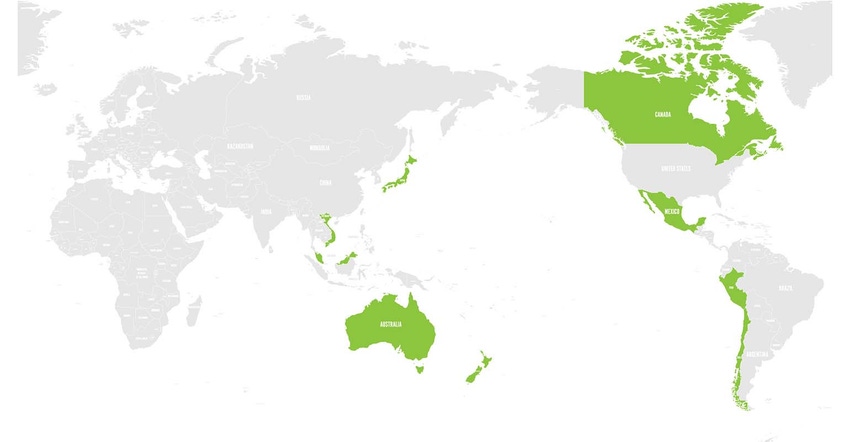
by Jason Scott, Bryce Baschuk and Josh Wingrove
Australia is on track to ratify a new Pacific trade deal by Nov. 1, the country’s trade minister said, a move that would trigger the first tariff cuts this year in an 11-nation accord that survived an exit by President Donald Trump.
The Japan-led Comprehensive and Progressive Agreement for Trans-Pacific Partnership, or CPTPP, will take provisional effect 60 days after six countries ratify it. Four have so far and Canada is set to on Monday. Should Australia do so by Nov. 1, the initial six signatories will enjoy two rounds of tariffs cuts by April 1.
“We believe that we are on track to be able to ratify and lodge notification with New Zealand by the first of November,” Australian Trade Minister Simon Birmingham said on the sidelines of the WTO reform ministerial meeting in Ottawa. “From all that we can tell, that puts us in good company with Mexico, Singapore, Japan, Canada and New Zealand to ensure there are the requisite six to bring it into force at the earliest possible opportunity.”
The deal’s enactment would be hailed by supporters as a victory for the global trading system bemoaned by Trump, who quit the original TPP deal. The CPTPP nations, representing 14% of global gross domestic product, are trying to expand the status quo view of free trade amid a tariff fight between Washington and Beijing and a simmering Brexit battle in Europe.
“CPTPP is the most important global trade arrangement in two decades,” said Deborah Elms, executive director of the Singapore-based Asian Trade Center. At a time of increasing protectionism, “it is striking how these governments grasp the importance of pushing ahead with transparent, rules-based trade that benefits large and small firms.”
Japan, Mexico, Singapore and New Zealand have already ratified the pact. Some CPTPP members had hoped the first six nations would meet a Nov. 1 target deadline, which would allow the deal to enter into force by Dec. 31.
That’s important because subsequent annual tariff cuts for 10 of the 11 nations can only occur every Jan. 1 -- Japan’s reductions come on April 1 of each year. If the deal kicks in on Dec. 31, the second round of tariff reductions for most countries can come the next day. Otherwise, they’d wait a year.
Australia, Canada
Canada’s Senate passed the law enacting the CPTPP on Thursday. Canada has some procedural steps left but expects to ratify Monday, a Canadian government official said, speaking on condition of anonymity. They’d be the fifth country. Australia is “going through the final i-dotting, t-crossing stages, which we hope will be completed within the next few days,” Birmingham said Thursday.
Government officials had warned Australia could miss the Nov. 1 deadline as they anticipated it may take weeks to complete the administrative and legal processes.
Before ratifying the pact, Australia needs to adjust customs regulations and change screening processes for investment proposals from some CPTPP nations, according to the government’s National Interest Analysis. Once the steps are completed, Australia will send a formal notification to New Zealand, which is the depository of the treaty.
Tariff reductions carry out over years, and differ by product. Countries are racing to be in the first group because they’d get a head-start on other member nations, an advantage that cascades for years. Japanese Prime Minister Shinzo Abe and Canadian Prime Minister Justin Trudeau -- representing the two biggest economies in the deal -- discussed the pact in a call this week, and “reiterated their commitment to ensuring an early entry into force,” Trudeau’s office said.
Others have downplayed the importance of Nov. 1.
“The sooner it is in effect, the sooner the tariff reductions that are promised under the agreement are triggered,” said New Zealand Trade Minister David Parker, speaking Thursday during a WTO meeting in Ottawa. “So obviously delay causes delay,” he said, adding that ratification by Australia and Canada is imminent.
‘At Stake’
Eyes are on Australia’s push to ratify by Nov. 1.
“We’ve got a race, and there’s quite a bit at stake,” said Heath Baker, head of trade policy at the Export Council of Australia. “I can imagine that all CPTPP members will be willing Australia to ratify this month so it can enter into force by the end of the year. That way everyone benefits, as they’re in a much better position from a perspective of more competitive tariffs than the parties outside the pact.”
Baker said it was very difficult to put a dollar figure on the benefits of meeting the deadline, and the size of the second round of reductions varied from nation to nation and industry to industry. “The modeling that has been done shows the longer the agreement is in force, the greater the benefits,” he said. “The faster you can get it started, the greater the returns will be down the track.”
Australia played a key role in reviving the Trans-Pacific Partnership after Trump withdrew support for the initial pact shortly after taking office. The 11 remaining members of the CPTPP agreed to a new deal in Chile in March, and aimed for it to be implemented through individual ratification by the end of this year. The pact will link nations with a collective GDP of $10.6 trillion.
Once the deal takes provisional effect, the other signatory countries will join 60 days after ratification, but could see a slower schedule of tariff reductions.
--With assistance from Shawn Donnan and Matthew Brockett.
To contact the reporters on this story: Jason Scott in Canberra at [email protected] ;Bryce Baschuk in Ottawa at [email protected] ;Josh Wingrove in Ottawa at [email protected]
To contact the editors responsible for this story: Ruth Pollard at [email protected] Daniel Ten Kate, Robert Jameson
© 2018 Bloomberg L.P
About the Author(s)
You May Also Like




